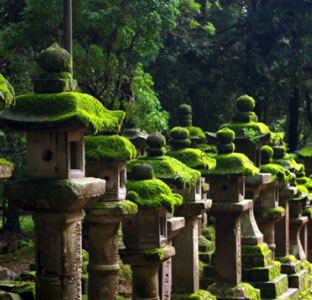East Asia Institute, Institute of Texan Cultures host Japan exhibit Jan. 15-March 13

"Living Lanterns," 2010, Kasuga Taisha shrine, Nara, Japan; photo by UTSA student Schuyler Costello, first-place winner (college level) of "Tea, Garden and Zen" photo contest associated with Japan photo exhibit

"Living Lanterns," 2010, Kasuga Taisha shrine, Nara, Japan; photo by UTSA student Schuyler Costello, first-place winner (college level) of "Tea, Garden and Zen" photo contest associated with Japan photo exhibit
(Jan. 13, 2011)--The UTSA East Asia Institute and the Institute of Texan Cultures will co-host "World Heritage Photo Panels from Japan: Two Thousand Years of Legacies," an exhibition of Japan's World Heritage sites. The exhibit will be on display Jan. 15-March 13.
Currently, 14 sites in Japan have been deemed World Heritage sites under the UNESCO World Heritage Convention. Some of the sites include the Shirakami-Sanchi Mountain Range, Yaku-shima Island, Himeji-jo Castle and the Buddhist monuments of the Horyu-ji Temple area.
"Places are an important part of culture," said John Davis, Institute of Texan Cultures interim executive director. "These significant sites have been a part of Japanese cultures for centuries, much like San Antonio's Spanish missions continue to play a role in our own society. This is a tremendous opportunity to learn about these cultural treasures."
The photo panels have been provided courtesy of the Japan Foundation of New York. The exhibit features 63 photographs of World Heritage sites in Japan taken by Japanese photographer Kazuyoshi Miyoshi. Japan is one of 168 countries that signed the United Nations Educational, Scientific and Cultural Organization's World Heritage Convention, pledging to the world that they will preserve for future generations the cultural and natural legacies of the world with conspicuous and universal value. Today, there are 851 World Heritage sites in 135 nations.
"Understanding other cultures is paramount in preparing citizen leaders for the global environment." said Mimi Yu, associate director of the UTSA East Asia Institute. "We are thankful to the Institute of Texan Cultures for this opportunity to collaborate."
The exhibit is a component of a larger East Asia Institute program, incorporating the "Tea, Garden and Zen" photo contest and "The Importance of Preservation" essay contest for grades K-12.
"As tangible evidence of humanity, historic places give us value and provide essential continuity in our quest for both natural and cultural sustainability," said William Dupont, San Antonio Conservation Society Endowed Professor in the UTSA College of Architecture. Dupont will lecture at the exhibit opening. He is the former chief architect for the National Trust for Historic Preservation and a board member of the U.S. National Committee of the International Council of Monuments and Sites.
The East Asia Institute will host additional programming at the museum during the exhibit's run. On Saturday, Jan. 22, Taeg Nishimoto, associate dean of the UTSA College of Architecture, will lecture on the philosophies of Zen Buddhism. The exhibit will be open during the museum's annual Asian Festival, Feb. 5. Japanese Culture Family Day will be from noon to 4 p.m., Feb. 26, showcasing Japanese customs, language, calligraphy, ink-wash painting and other hands-on activities.
"World Heritage Photo Panels from Japan: Two Thousand Years of Legacies" is co-hosted by the UTSA East Asia Institute and sponsored by H-E-B, the Japan America Society of San Antonio and the Japan Foundation of New York.
The Institute of Texan Cultures is on the UTSA HemisFair Park Campus, 801 E. Durango Blvd., a short distance from the Alamo and the River Walk. Hours are 9 a.m.-5 p.m., Monday-Saturday; noon-5 p.m., Sunday. Admission to the exhibit is complimentary, but does not include admission to the main exhibit floor. Regular admission is $8 for adults (ages 12-64); $7 for seniors (ages 65+); $6 for children (ages 3-11); free with membership, UTSA or Alamo Colleges identification.
For more information, call 210-458-2300 or visit TexanCultures.com.
Events
The UTSA Office of Undergraduate is proud to celebrate National Undergraduate Research with an annual event sponsored by the (OUR) featuring students will showcase undergraduate student research and creative endeavors from all disciplines across campus.
Various LocationsThis community event is hosted by the UTSA Mexican American Studies Program. It is a lecture/performance that examines the contributions of Tejana musicians to the evolution of Mexican American music.
Esperanza Peace & Justice Center, 922 San Pedro Ave.Asian Fanfair is an event that highlights our APIDA (Asian Pacific Islander Desi American) identities on campus. The event will feature performances from our AAPI interest Student Organizations, a tabling fair, and some cultural cuisine.
Student Union Paseo, Main CampusJoin us for a day dedicated to supporting and empowering our UTSA veterans! We're excited to announce our upcoming resource fair, designed specifically to ensure that our veteran students have access to the resources and networking opportunities they need to thrive in their academic and post-military lives.
Student Union Lawn, Main CampusThis workshop will introduce participants to the basics of text analysis using Python and Jupyter Notebook on the Constellate Lab platform. We will create datasets in Constellate to analyze patterns, trends, and relationships of contents and more.
John Peace Library (JPL 3.02.32), Main CampusWhat would award-winning writing professor Diane Abdo say if it were her last lecture? Join us for our annual Last Lecture series on Wednesday April 17.
Multipurpose Room (BSE 2.102), Main CampusDía en la Sombrilla, formerly Fiesta UTSA, is a festival hosted each spring as a part of Fiesta® San Antonio events. Sponsored by Roadrunner Productions, the event features music, food, confetti, games, event t-shirts, and more.
Sombrilla Plaza and Central Plaza, Main Campus

